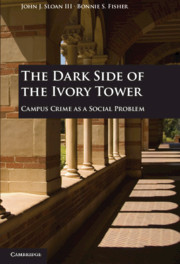Book contents
- Frontmatter
- Contents
- Preface
- Acknowledgments
- The Dark Side of The Ivory Tower
- Chapter One Violence, Vice, and Victimization on American College and University Campuses
- Chapter Two Constructing Campus Crime as a New Social Problem
- Chapter Three Constructing Unsafe and Violent College Campuses
- Chapter Four Constructing the Sexual Victimization of College Women on Campus
- Chapter Five Constructing Postsecondary Institutional Liability for Campus Crime
- Chapter Six Constructing Binge Drinking on College Campuses
- Chapter Seven The Legacy of Claimsmakers
- Index
- References
Chapter Four - Constructing the Sexual Victimization of College Women on Campus
Published online by Cambridge University Press: 05 June 2012
- Frontmatter
- Contents
- Preface
- Acknowledgments
- The Dark Side of The Ivory Tower
- Chapter One Violence, Vice, and Victimization on American College and University Campuses
- Chapter Two Constructing Campus Crime as a New Social Problem
- Chapter Three Constructing Unsafe and Violent College Campuses
- Chapter Four Constructing the Sexual Victimization of College Women on Campus
- Chapter Five Constructing Postsecondary Institutional Liability for Campus Crime
- Chapter Six Constructing Binge Drinking on College Campuses
- Chapter Seven The Legacy of Claimsmakers
- Index
- References
Summary
Until the 1980s, most people assumed that college campuses were a safe environment for women. The little concern that existed for women’s safety on campus was limited to stranger rapes, although these are relatively rare compared to women’s victimization by men they know.
Sadly, the sexual victimization of college women on campus is nothing new. The stereotypical lecherous professor not only has been parodied in the arts but has become symbolic of how some members of the academy exploit their positions to garner sexual favors from students. Beyond suffering sexual harassment from their professors, college women also experience various forms of sexual harassment from their peers as well. Further, empirical evidence reveals that sexual assaults of college women by college men – including coercive fondling and rape – also occur with some frequency on college campuses. Only since the 1980s, however, has discourse about the sexual victimization of college women on campus changed, resulting not only in new orientations toward the issue but in policies aimed at both preventing it and responding to such behavior when it occurs.
To understand how the construction of campus crime as a new social problem occurred during the late 1980s and into the 1990s, we now look at a second group of claimsmakers, campus feminists, outraged over what they saw as “epidemic levels” of sexual victimization experienced on campus by female students throughout their collegiate years. Campus feminists claimed that young women enrolled at postsecondary institutions and hoping to obtain educational and economic equality were experiencing neither. Instead, they were being subjected not only to the physical and emotional horrors of being raped or sexually assaulted by dates and acquaintances (primarily college men) but also to the horror of having college or university administrators disbelieve, discredit, or attempt to silence them in an effort to preserve the public images of their colleges and universities. Just as Security On Campus, Inc., constructed the new problem of unsafe and violent college campuses by claiming that on-campus violence was rampant, that college or university administrators knew this but failed to take appropriate steps to address the problem, and that they also failed to adequately address the needs of victims, campus feminists, concerned with the sexual victimization of college women, likewise focused their attention on three fronts.
- Type
- Chapter
- Information
- The Dark Side of the Ivory TowerCampus Crime as a Social Problem, pp. 81 - 110Publisher: Cambridge University PressPrint publication year: 2010

